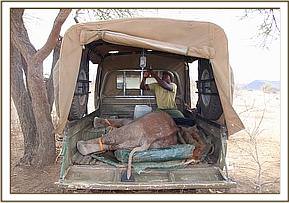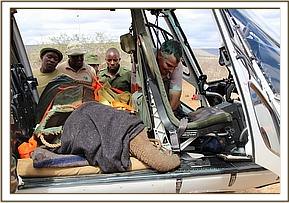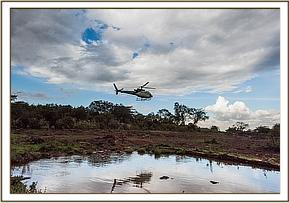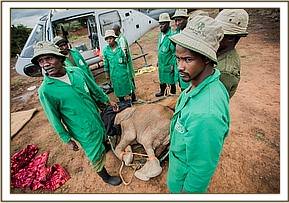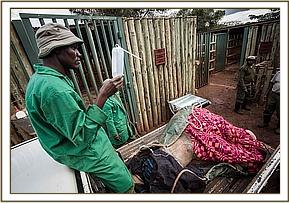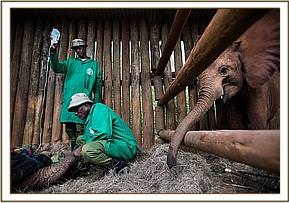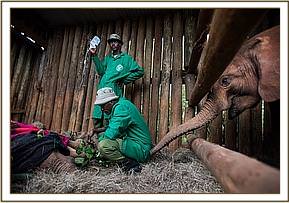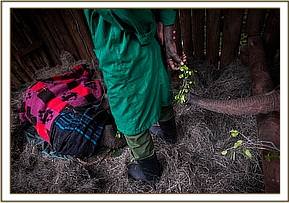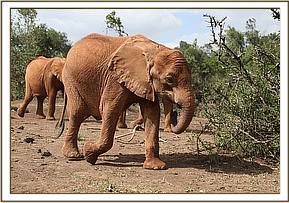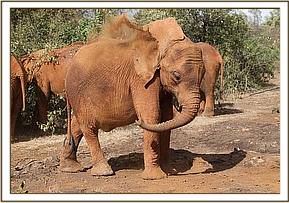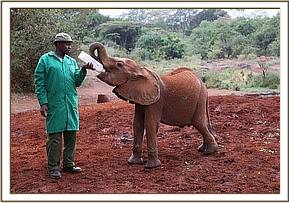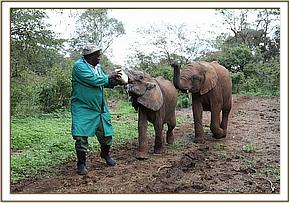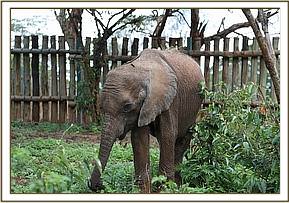









Now living wild, though he continues to visit us regularly
Current age
9 years old
Gender
Male
Rescued date
2 November 2017
Rescue location
Tsavo Ecosystem, Tsavo East NP
Date of birth (estimate)
6 November 2016
Reason orphaned
Drought related
Age at rescue
11 months old (approx)
Current location
Ithumba Reintegration Unit
A herd remained in the area close to the Mapea gap, where the elephant herds traverse through a natural depression in the Yatta, accessing the southern and northern areas of what is now known as the Tsavo East National Park. The Galana River flows through Tsavo East at the base of the Yatta Plateau and eventually onto the Indian Ocean. David Sheldrick, as the founding warden of Tsavo, first built the road across the Galana River, the Lugards Falls causeway and over the Yatta following the contours of well traversed elephant paths and this has formed the access between the southern and northern areas of the park ever since. It was on a similar path that this spent, ravaged and completely parched baby elephant lay.
The Rangers were not actually sure he was still alive, and certainly didn’t fancy his chances of lasting until ground teams from Voi reached him. Thankfully they were swift to report his plight over the radio alerting our Voi elephant Keepers and the SWT team accompanied by additional KWS Rangers rushed to the site. Due to the drought our teams have become well versed in the life saving protocols required to retrieve desperate drought-stricken victims who simply can no longer continue, so they carried with them all the necessary supplies and equipment required. At the same time the SWT helicopter pilot Andy Payne was informed too so he prepared everything from his end, based out of our Kaluku Field headquarters. With ground teams and air rescue well coordinated unnecessary delays were avoided as with this case it was clear every minute was going to count.
By the time the team arrived on site, a one hour drive from Voi, HQ for the southern section of Tsavo East, the situation looked bleak. Despite the elephant herd lingering on the banks of the river we were forced to move the recumbent calf into the Landcruiser and make a hasty retreat to Lugards airfield on the south bank of the Galana River, just a short 5km drive away. Once there they lifted the baby out of the Landcruiser and lay him in the shade of an acacia tortilis tree, and immediately set about trying to revive him, placing an IV drip into the calf’s by now sunken veins so low was his blood pressure. To everyone’s relief after a while he stirred and they dared hope that just maybe they were in time to save his precious life. As they stabilized him, ensuring he received a healthy amount of fluids into his system, his eyes opened and he became increasingly responsive.
He was now prepared for transport, all during the most brutal time of day at 3.00pm with temperatures soaring, reaching some 38 degrees in the shade. By now Andy in the SWT helicopter had arrived at the strip, and having removed the back seats already was prepared so the calf was carefully lifted and maneuvered into the aircraft and made comfortable with his legs safely strapped, all the while the IV fluids were still dripping into him. Without delay he was up and away and headed for our Nairobi Nursery as he was going to need serious intensive care for weeks and months to come back from the brink. Fittingly we named this young calf, estimated to be approximately a year old, Mapia, after the location where he was miraculously found in time.
A herd remained in the area close to the Mapea gap, where the elephant herds traverse through a natural depression in the Yatta, accessing the southern and northern areas of what is now known as the Tsavo East National Park. The Galana River flows through Tsavo East at the base of the Yatta Plateau and eventually onto the Indian Ocean. David Sheldrick, as the founding warden of Tsavo, first built the road across the Galana River, the Lugards Falls causeway and over the Yatta following the contours of well traversed elephant paths and this has formed the access between the southern and northern areas of the park ever since. It was on a similar path that this spent, ravaged and completely parched baby elephant lay.

View diary updates from across all our orphan units as written by the Keepers

June has been an extremely hectic month with three elephant relocations to our Reintegration Units, which has seen us move a total of eight older Nursery orphans to Tsavo during this cooler month. These orphans now have the opportunity of exposure to the wild elephant herds, honing their social and emotional skills and equipping them with all they will need to know before successfully assimilating into the wild population in time.
By adopting, you play a vital role in the life of an orphaned elephant, rhino, or giraffe — helping us provide the round-the-clock, loving attention each one needs and deserves over many years, so they can ultimately reclaim their place in the wild.
Your adoption supports the 100+ orphans in our care at any given time, covering the cost of milk and food supplies, Keepers' salaries, veterinary treatment, and other essentials.

Celebrate your adoption with a personalised certificate, ready for you or your lucky gift recipient to print and display!

Each month, we send a detailed update about our Orphans’ Project direct to your email inbox, featuring photos, stories, and special highlights.

From the latest Keepers’ Diaries to a downloadable image gallery and more, adopters have exclusive access to our content library.
